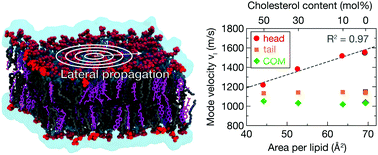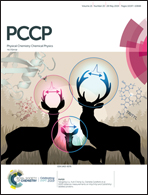Hydration-mediated stiffening of collective membrane dynamics by cholesterol†
Abstract
The collective behaviour of individual lipid molecules determines the properties of phospholipid membranes. However, the collective molecular motions often remain challenging to characterise at the desired spatial and temporal resolution. Here we study collective vibrational motion on picosecond time scales in dioleoylphosphatidylcholine lipid bilayers with varying cholesterol content using all-atom molecular dynamics simulations. Cholesterol is found to not only laterally compact the lipid bilayer, but also to change the velocity of longitudinal density fluctuations propagating in the plane of the membrane. Cholesterol-induced reduction of the area per lipid alters the collective dynamics of the lipid headgroups, but not of the lipid tails. The introduction of cholesterol reduces the number of water molecules interacting with the lipid headgroups, leading to a decrease in the velocity of the laterally-propagating sound mode. Thus, the stiffening effect of cholesterol is found to be indirect: decreasing the area per lipid weakens the interactions between the lipid headgroups and water. The collective modes characterised in this work can enable the membrane to dissipate excess energy and thus maintain its structural integrity, e.g., under mechanical stress.



 Please wait while we load your content...
Please wait while we load your content...